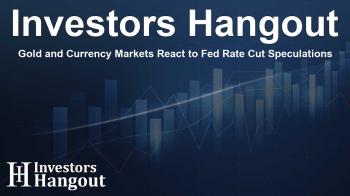Gold and Currency Markets React to Fed Rate Cut Speculations

Anticipation Grows for Rate Cuts as Gold Prices Remain Steady
Currently, gold prices are holding steady, hovering around $3,350 per ounce. This comes as traders closely monitor the latest inflation data from the United States. July's headline inflation was lower than anticipated; however, core inflation exceeded expectations, suggesting that the Federal Reserve might consider a rate cut in the near future. Traders view such cuts favorably, as lower interest rates can enhance the appeal of gold compared to interest-earning assets.
The geopolitical landscape is also a significant factor affecting gold prices. The recent extension of the tariff truce between the US and China has contributed to a climate of cautious optimism among investors. Furthermore, speculation surrounding potential discussions between the US and Russia regarding the ongoing Ukraine conflict is creating ripples in the market.
It's essential for traders to remain vigilant regarding central bank announcements and geopolitical developments. Any signals indicating possible rate cuts from the Fed or escalated global tensions typically intensify interest in gold as a safe-haven investment.
US Dollar Experiences Decline as Euro Gains Strength
Amid these shifts, the euro has been on an upward trend, buoyed by reactions to recent CPI reports from the US. The euro’s value has increased while the US dollar has seen a decline. This is largely attributed to expectations that the Federal Reserve will lower interest rates, intensifying the downward pressure on the dollar.
The depreciation of the US dollar is partly due to alleviated anxieties surrounding US–China trade relations. The agreement to prolong the truce between the two nations has eased some market tensions. Additionally, upcoming dialogues between US and Russian leadership are contributing to a more favorable outlook for the euro.
For those trading in euros, it's crucial to monitor upcoming decisions from the Federal Reserve and any news regarding both US–China and US–Russia relations. Developments in these areas could further influence the euro's performance.
Understanding the Yen's Performance: Key Insights for Traders
The Japanese yen has recently shown signs of weakness, influenced by uncertainty regarding the Bank of Japan's policies on interest rates. Investors are unsure when the BoJ will implement a rate hike, but there is a prevailing sentiment that the central bank will continue its course toward policy normalization.
Compounding the yen's challenges, the expectation for the US Federal Reserve to lower interest rates adds pressure to the Japanese currency. This environment decreases the yen's appeal as a safe-haven asset compared to the more enticing US dollar.
Traders should pay close attention to the upcoming US PPI data and Japan's GDP preview as these releases are likely to create volatility in the USD/JPY pair. Staying updated on these developments will aid in making informed trading decisions.
Factors Influencing Currency and Gold Prices
As traders navigate the current market landscape, several factors contribute to fluctuations in gold and currency values. Central bank decisions typically play a crucial role in setting expectations; hence, traders must analyze statements from the Fed and other global financial institutions.
The interplay between inflation data and market perceptions surrounding future rate cuts remains a significant driver of gold prices. Additionally, geopolitical events—such as trade negotiations and international relations—can lead to unexpected market reactions.
The volatility in the currency markets, particularly for the US dollar, euro, and Japanese yen, often reflects broader economic conditions and investor sentiment. Watching these developments is essential for anyone involved in trading or investing in these currencies.
Frequently Asked Questions
What factors are currently affecting gold prices?
Gold prices are influenced by expectations of Federal Reserve rate cuts, inflation reports, and geopolitical events such as trade tensions and international conflicts.
How do rate cuts impact the US dollar?
Rate cuts typically lead to a weaker US dollar, as they decrease the return on dollar-denominated assets, making them less attractive to investors.
Why is the euro gaining strength?
The euro is rising due to a combination of favorable economic data and reduced tensions in US–China trade relations, coupled with expectations around the Federal Reserve's monetary policy.
What should traders watch for in the coming weeks?
Traders should pay attention to upcoming central bank meetings, inflation data releases, and geopolitical developments that could impact market volatility.
How does geopolitical tension affect currency trading?
Geopolitical tensions can lead to heightened uncertainty in the markets, prompting investors to seek safe-haven assets, which can influence currency valuations, notably for the yen and gold.
About The Author
Contact Caleb Price privately here. Or send an email with ATTN: Caleb Price as the subject to contact@investorshangout.com.
About Investors Hangout
Investors Hangout is a leading online stock forum for financial discussion and learning, offering a wide range of free tools and resources. It draws in traders of all levels, who exchange market knowledge, investigate trading tactics, and keep an eye on industry developments in real time. Featuring financial articles, stock message boards, quotes, charts, company profiles, and live news updates. Through cooperative learning and a wealth of informational resources, it helps users from novices creating their first portfolios to experts honing their techniques. Join Investors Hangout today: https://investorshangout.com/
The content of this article is based on factual, publicly available information and does not represent legal, financial, or investment advice. Investors Hangout does not offer financial advice, and the author is not a licensed financial advisor. Consult a qualified advisor before making any financial or investment decisions based on this article. This article should not be considered advice to purchase, sell, or hold any securities or other investments. If any of the material provided here is inaccurate, please contact us for corrections.

